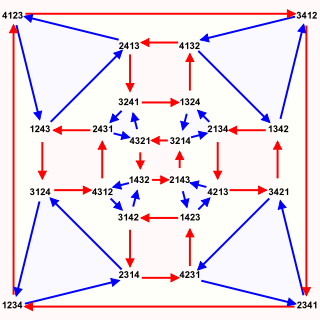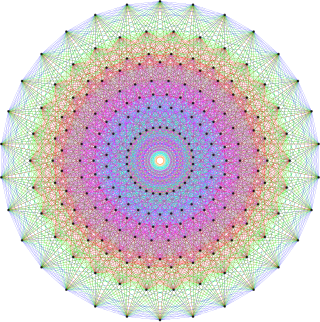In mathematics, the determinant is a scalar-valued function of the entries of a square matrix. The determinant of a matrix A is commonly denoted det(A), det A, or |A|. Its value characterizes some properties of the matrix and the linear map represented, on a given basis, by the matrix. In particular, the determinant is nonzero if and only if the matrix is invertible and the corresponding linear map is an isomorphism.

In abstract algebra, the symmetric group defined over any set is the group whose elements are all the bijections from the set to itself, and whose group operation is the composition of functions. In particular, the finite symmetric group defined over a finite set of symbols consists of the permutations that can be performed on the symbols. Since there are such permutation operations, the order of the symmetric group is .

In the mathematical field of group theory, Lagrange's theorem is a theorem that states that for any finite group G, the order of every subgroup of G divides the order of G. The theorem is named after Joseph-Louis Lagrange. The following variant states that for a subgroup of a finite group , not only is an integer, but its value is the index , defined as the number of left cosets of in .

In mathematics, a permutation of a set can mean one of two different things:

In mathematics, an alternating group is the group of even permutations of a finite set. The alternating group on a set of n elements is called the alternating group of degree n, or the alternating group on n letters and denoted by An or Alt(n).

In mathematics, an involution, involutory function, or self-inverse function is a function f that is its own inverse,
This is an outline of topics related to linear algebra, the branch of mathematics concerning linear equations and linear maps and their representations in vector spaces and through matrices.
In mathematics, and in particular in group theory, a cyclic permutation is a permutation consisting of a single cycle. In some cases, cyclic permutations are referred to as cycles; if a cyclic permutation has k elements, it may be called a k-cycle. Some authors widen this definition to include permutations with fixed points in addition to at most one non-trivial cycle. In cycle notation, cyclic permutations are denoted by the list of their elements enclosed with parentheses, in the order to which they are permuted.
In linear algebra, a circulant matrix is a square matrix in which all rows are composed of the same elements and each row is rotated one element to the right relative to the preceding row. It is a particular kind of Toeplitz matrix.

Symmetry occurs not only in geometry, but also in other branches of mathematics. Symmetry is a type of invariance: the property that a mathematical object remains unchanged under a set of operations or transformations.
In mathematics, the Chevalley–Shephard–Todd theorem in invariant theory of finite groups states that the ring of invariants of a finite group acting on a complex vector space is a polynomial ring if and only if the group is generated by pseudoreflections. In the case of subgroups of the complex general linear group the theorem was first proved by G. C. Shephard and J. A. Todd who gave a case-by-case proof. Claude Chevalley soon afterwards gave a uniform proof. It has been extended to finite linear groups over an arbitrary field in the non-modular case by Jean-Pierre Serre.

In mathematics, a matrix is a rectangular array or table of numbers, symbols, or expressions, arranged in rows and columns, which is used to represent a mathematical object or property of such an object.
In linear algebra, the computation of the permanent of a matrix is a problem that is thought to be more difficult than the computation of the determinant of a matrix despite the apparent similarity of the definitions.

In computer science and discrete mathematics, an inversion in a sequence is a pair of elements that are out of their natural order.